Coca Cola's Key Operations, Logistics and Supply Chain Management
VerifiedAdded on 2023/06/18
|9
|2855
|500
Essay
AI Summary
This essay provides an in-depth analysis of Coca Cola's operations management, logistics, and supply chain strategies. It discusses new product development processes, including opportunity evaluation, feedback integration, performance assurance, manufacturing design, prototype building, and product launch. The report further examines Coca Cola's commitment to Total Quality Management (TQM) since 1995, focusing on consistent quality, safety, and environmental standards. Additionally, the study highlights Coca Cola's Triple Bottom Line approach, considering economic growth, social campaigns, and environmental efforts, including water conservation and carbon footprint reduction. The essay concludes with recommendations for Coca Cola to focus on new product development and maintain quality standards to enhance customer satisfaction and market share. Desklib offers a platform to access this essay and many other resources for students.
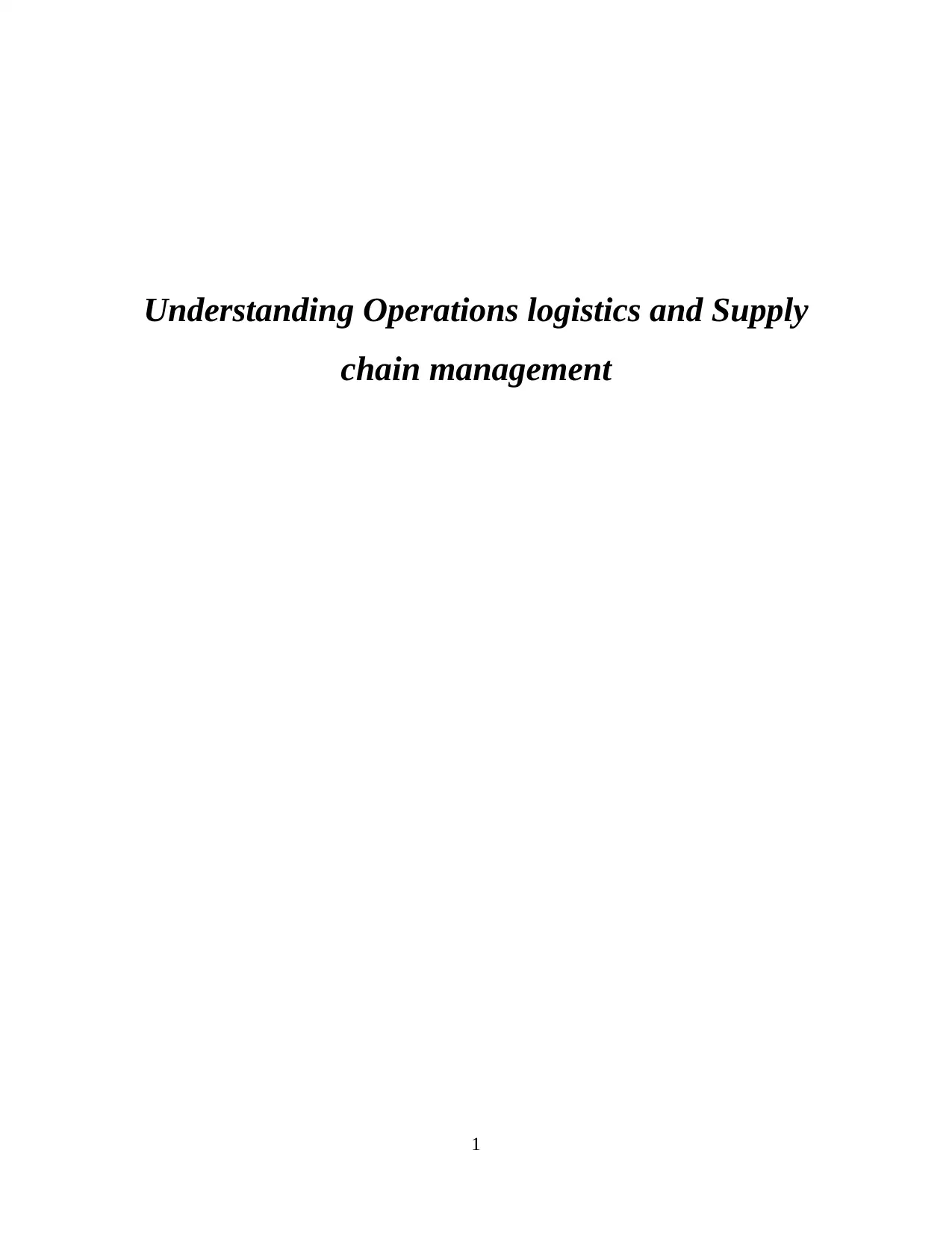
Understanding Operations logistics and Supply
chain management
1
chain management
1
Secure Best Marks with AI Grader
Need help grading? Try our AI Grader for instant feedback on your assignments.
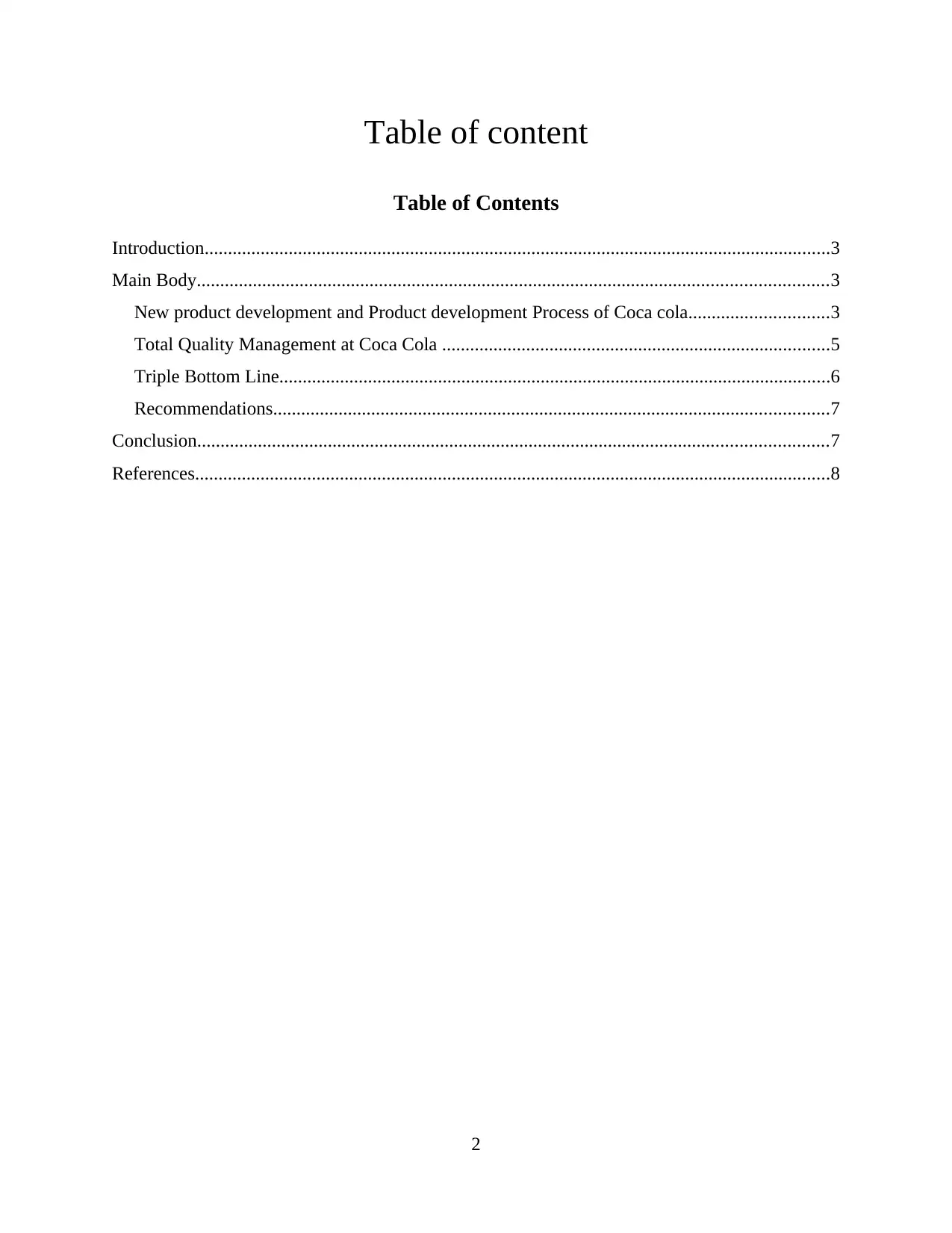
Table of content
Table of Contents
Introduction......................................................................................................................................3
Main Body.......................................................................................................................................3
New product development and Product development Process of Coca cola..............................3
Total Quality Management at Coca Cola ...................................................................................5
Triple Bottom Line......................................................................................................................6
Recommendations.......................................................................................................................7
Conclusion.......................................................................................................................................7
References........................................................................................................................................8
2
Table of Contents
Introduction......................................................................................................................................3
Main Body.......................................................................................................................................3
New product development and Product development Process of Coca cola..............................3
Total Quality Management at Coca Cola ...................................................................................5
Triple Bottom Line......................................................................................................................6
Recommendations.......................................................................................................................7
Conclusion.......................................................................................................................................7
References........................................................................................................................................8
2
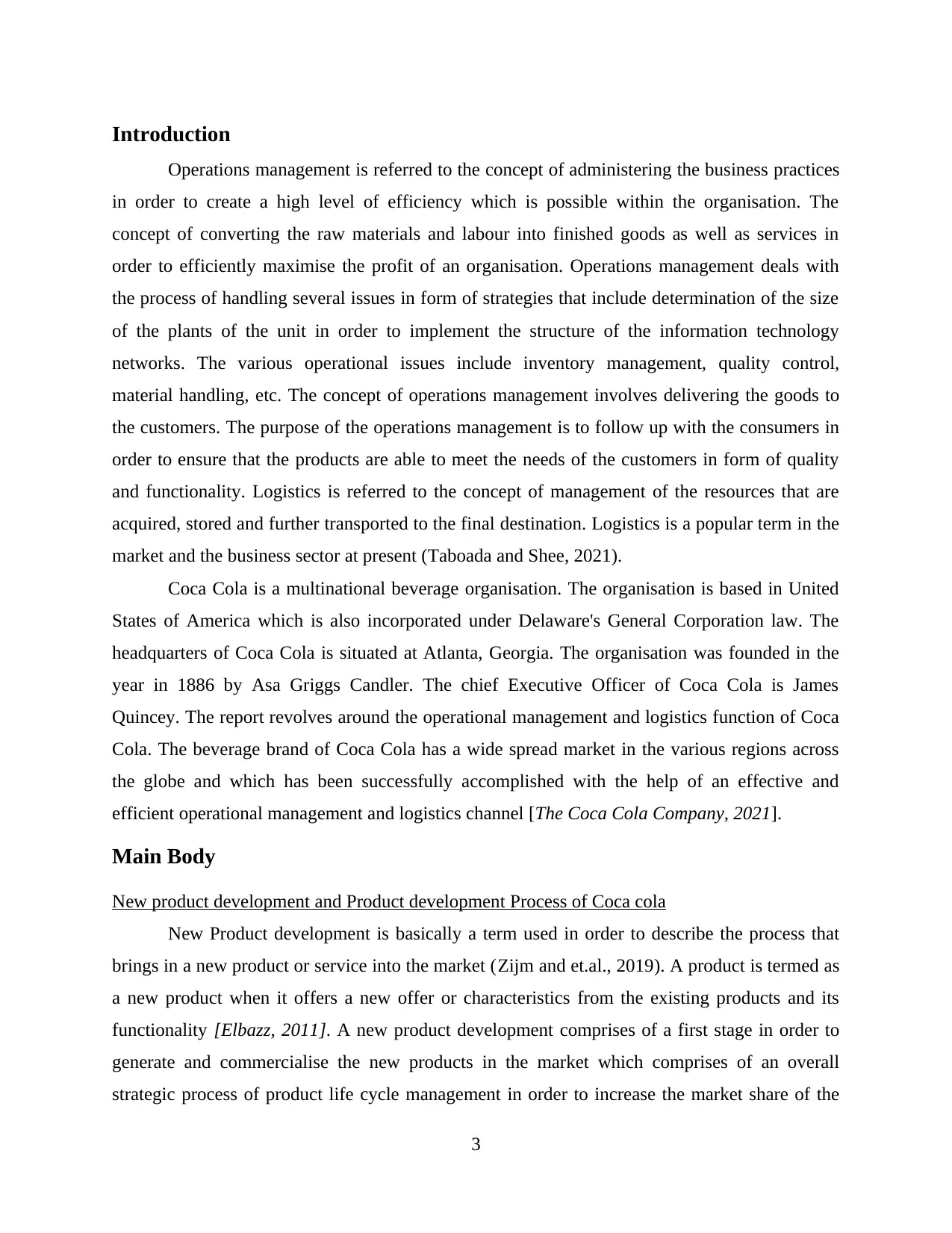
Introduction
Operations management is referred to the concept of administering the business practices
in order to create a high level of efficiency which is possible within the organisation. The
concept of converting the raw materials and labour into finished goods as well as services in
order to efficiently maximise the profit of an organisation. Operations management deals with
the process of handling several issues in form of strategies that include determination of the size
of the plants of the unit in order to implement the structure of the information technology
networks. The various operational issues include inventory management, quality control,
material handling, etc. The concept of operations management involves delivering the goods to
the customers. The purpose of the operations management is to follow up with the consumers in
order to ensure that the products are able to meet the needs of the customers in form of quality
and functionality. Logistics is referred to the concept of management of the resources that are
acquired, stored and further transported to the final destination. Logistics is a popular term in the
market and the business sector at present (Taboada and Shee, 2021).
Coca Cola is a multinational beverage organisation. The organisation is based in United
States of America which is also incorporated under Delaware's General Corporation law. The
headquarters of Coca Cola is situated at Atlanta, Georgia. The organisation was founded in the
year in 1886 by Asa Griggs Candler. The chief Executive Officer of Coca Cola is James
Quincey. The report revolves around the operational management and logistics function of Coca
Cola. The beverage brand of Coca Cola has a wide spread market in the various regions across
the globe and which has been successfully accomplished with the help of an effective and
efficient operational management and logistics channel [The Coca Cola Company, 2021].
Main Body
New product development and Product development Process of Coca cola
New Product development is basically a term used in order to describe the process that
brings in a new product or service into the market (Zijm and et.al., 2019). A product is termed as
a new product when it offers a new offer or characteristics from the existing products and its
functionality [Elbazz, 2011]. A new product development comprises of a first stage in order to
generate and commercialise the new products in the market which comprises of an overall
strategic process of product life cycle management in order to increase the market share of the
3
Operations management is referred to the concept of administering the business practices
in order to create a high level of efficiency which is possible within the organisation. The
concept of converting the raw materials and labour into finished goods as well as services in
order to efficiently maximise the profit of an organisation. Operations management deals with
the process of handling several issues in form of strategies that include determination of the size
of the plants of the unit in order to implement the structure of the information technology
networks. The various operational issues include inventory management, quality control,
material handling, etc. The concept of operations management involves delivering the goods to
the customers. The purpose of the operations management is to follow up with the consumers in
order to ensure that the products are able to meet the needs of the customers in form of quality
and functionality. Logistics is referred to the concept of management of the resources that are
acquired, stored and further transported to the final destination. Logistics is a popular term in the
market and the business sector at present (Taboada and Shee, 2021).
Coca Cola is a multinational beverage organisation. The organisation is based in United
States of America which is also incorporated under Delaware's General Corporation law. The
headquarters of Coca Cola is situated at Atlanta, Georgia. The organisation was founded in the
year in 1886 by Asa Griggs Candler. The chief Executive Officer of Coca Cola is James
Quincey. The report revolves around the operational management and logistics function of Coca
Cola. The beverage brand of Coca Cola has a wide spread market in the various regions across
the globe and which has been successfully accomplished with the help of an effective and
efficient operational management and logistics channel [The Coca Cola Company, 2021].
Main Body
New product development and Product development Process of Coca cola
New Product development is basically a term used in order to describe the process that
brings in a new product or service into the market (Zijm and et.al., 2019). A product is termed as
a new product when it offers a new offer or characteristics from the existing products and its
functionality [Elbazz, 2011]. A new product development comprises of a first stage in order to
generate and commercialise the new products in the market which comprises of an overall
strategic process of product life cycle management in order to increase the market share of the
3
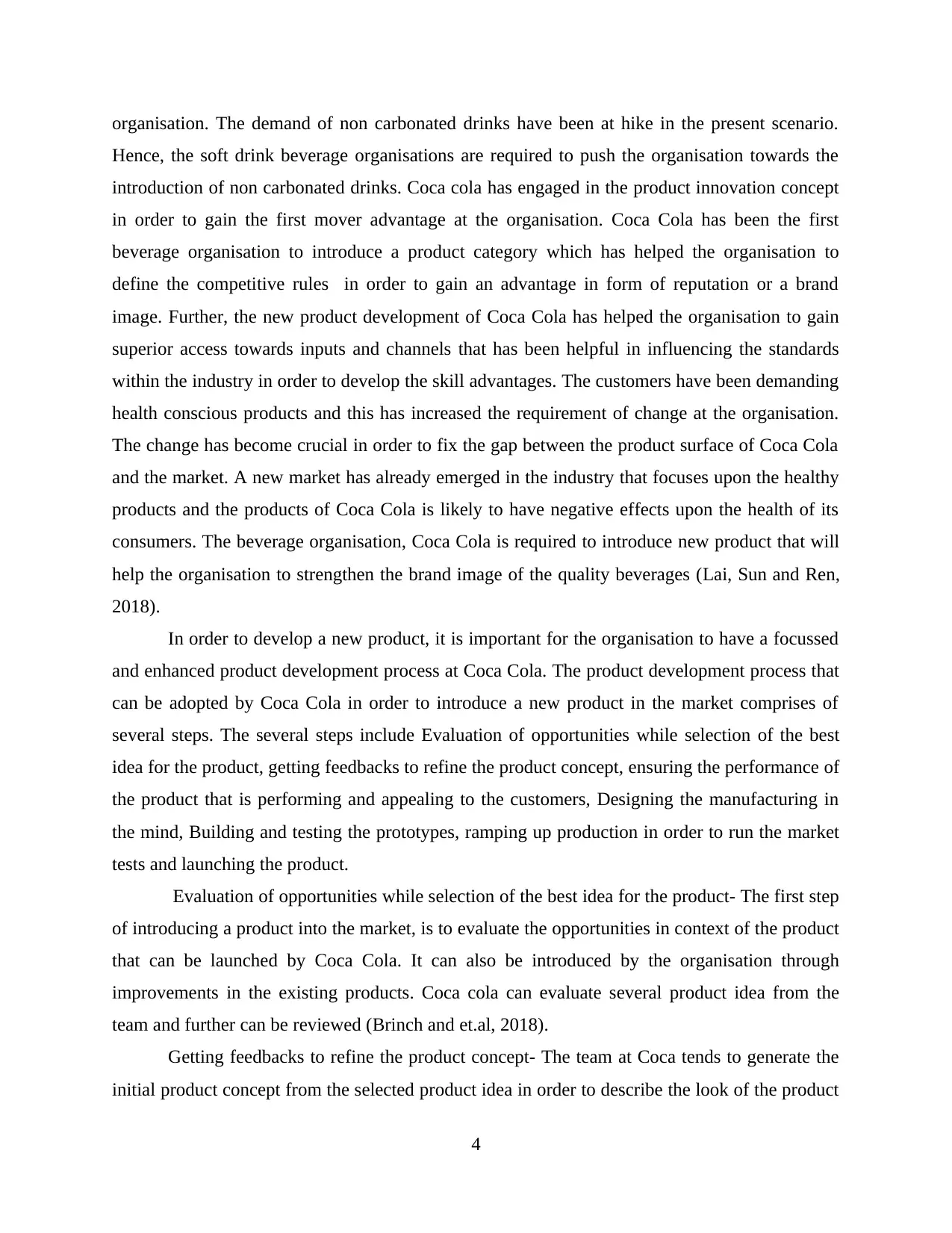
organisation. The demand of non carbonated drinks have been at hike in the present scenario.
Hence, the soft drink beverage organisations are required to push the organisation towards the
introduction of non carbonated drinks. Coca cola has engaged in the product innovation concept
in order to gain the first mover advantage at the organisation. Coca Cola has been the first
beverage organisation to introduce a product category which has helped the organisation to
define the competitive rules in order to gain an advantage in form of reputation or a brand
image. Further, the new product development of Coca Cola has helped the organisation to gain
superior access towards inputs and channels that has been helpful in influencing the standards
within the industry in order to develop the skill advantages. The customers have been demanding
health conscious products and this has increased the requirement of change at the organisation.
The change has become crucial in order to fix the gap between the product surface of Coca Cola
and the market. A new market has already emerged in the industry that focuses upon the healthy
products and the products of Coca Cola is likely to have negative effects upon the health of its
consumers. The beverage organisation, Coca Cola is required to introduce new product that will
help the organisation to strengthen the brand image of the quality beverages (Lai, Sun and Ren,
2018).
In order to develop a new product, it is important for the organisation to have a focussed
and enhanced product development process at Coca Cola. The product development process that
can be adopted by Coca Cola in order to introduce a new product in the market comprises of
several steps. The several steps include Evaluation of opportunities while selection of the best
idea for the product, getting feedbacks to refine the product concept, ensuring the performance of
the product that is performing and appealing to the customers, Designing the manufacturing in
the mind, Building and testing the prototypes, ramping up production in order to run the market
tests and launching the product.
Evaluation of opportunities while selection of the best idea for the product- The first step
of introducing a product into the market, is to evaluate the opportunities in context of the product
that can be launched by Coca Cola. It can also be introduced by the organisation through
improvements in the existing products. Coca cola can evaluate several product idea from the
team and further can be reviewed (Brinch and et.al, 2018).
Getting feedbacks to refine the product concept- The team at Coca tends to generate the
initial product concept from the selected product idea in order to describe the look of the product
4
Hence, the soft drink beverage organisations are required to push the organisation towards the
introduction of non carbonated drinks. Coca cola has engaged in the product innovation concept
in order to gain the first mover advantage at the organisation. Coca Cola has been the first
beverage organisation to introduce a product category which has helped the organisation to
define the competitive rules in order to gain an advantage in form of reputation or a brand
image. Further, the new product development of Coca Cola has helped the organisation to gain
superior access towards inputs and channels that has been helpful in influencing the standards
within the industry in order to develop the skill advantages. The customers have been demanding
health conscious products and this has increased the requirement of change at the organisation.
The change has become crucial in order to fix the gap between the product surface of Coca Cola
and the market. A new market has already emerged in the industry that focuses upon the healthy
products and the products of Coca Cola is likely to have negative effects upon the health of its
consumers. The beverage organisation, Coca Cola is required to introduce new product that will
help the organisation to strengthen the brand image of the quality beverages (Lai, Sun and Ren,
2018).
In order to develop a new product, it is important for the organisation to have a focussed
and enhanced product development process at Coca Cola. The product development process that
can be adopted by Coca Cola in order to introduce a new product in the market comprises of
several steps. The several steps include Evaluation of opportunities while selection of the best
idea for the product, getting feedbacks to refine the product concept, ensuring the performance of
the product that is performing and appealing to the customers, Designing the manufacturing in
the mind, Building and testing the prototypes, ramping up production in order to run the market
tests and launching the product.
Evaluation of opportunities while selection of the best idea for the product- The first step
of introducing a product into the market, is to evaluate the opportunities in context of the product
that can be launched by Coca Cola. It can also be introduced by the organisation through
improvements in the existing products. Coca cola can evaluate several product idea from the
team and further can be reviewed (Brinch and et.al, 2018).
Getting feedbacks to refine the product concept- The team at Coca tends to generate the
initial product concept from the selected product idea in order to describe the look of the product
4
Secure Best Marks with AI Grader
Need help grading? Try our AI Grader for instant feedback on your assignments.

along with its efficiency. The organisation tends to conduct a research upon the customer needs
and demands along with the benefits that are being expected from the brand. After the research,
the organisation will revise the product concept that tends to pinpoint the alternative models as
well (Brinch, 2018).
Ensuring the performance of the product that is performing and appealing to the
customers- The team of Coca Coal will then focus upon the concept of processing the product.
The stage tends to cover the assembling of the products and further where the products can be
obtained in order to get a final output.
Designing the manufacturing in the mind- In this stage the brand tends to focus upon the
concept of producing high quality products in order to get the attention of the customers while
minimising the cost and simplifying the components. The aim of the organisation is to build
quality as well as the efficiency within the process of manufacturing (Zissis, D., and et.al., 2019).
Building and testing the prototypes- Prototypes is referred as the physical model of the
product and in the next stage, the prototypes are produced as well as tested in order to ensure that
the product is helpful in meeting the needs and demands of the customers.
Ramping up production in order to run the market tests- In this stage, the employees are
trained in terms of the manufacturing and assembling process. The products that turn out during
the phase are carefully required to inspect the residual flaws. The samples tend to act as a
demonstration for testing as well as the feedbacks.
Product Launch- The final stage is the launch of the product after a successful testing and
feedbacks in the market and in the industry (Behl and Dutta, 2019).
Total Quality Management at Coca Cola
Total Quality Management is referred as he activity of the management function that tend
to influence the to influence the quality of the policies along with the responsibilities as well as
objectives that then helps in implementation upon the quality control, quality planning as well a
quality improvement [Jane 2019]. The concept of quality management the organisation tends to
focus upon the enhancement of the process in aspect of the quality. This helps in adding value to
the quality of the products that will help in enhancing the future. The concept of total quality
management comprises of the competitive moves along with the approaches of the business that
aims to produce successful performance (Banomyong, Varadejsatitwong and Oloruntoba, 2019).
5
and demands along with the benefits that are being expected from the brand. After the research,
the organisation will revise the product concept that tends to pinpoint the alternative models as
well (Brinch, 2018).
Ensuring the performance of the product that is performing and appealing to the
customers- The team of Coca Coal will then focus upon the concept of processing the product.
The stage tends to cover the assembling of the products and further where the products can be
obtained in order to get a final output.
Designing the manufacturing in the mind- In this stage the brand tends to focus upon the
concept of producing high quality products in order to get the attention of the customers while
minimising the cost and simplifying the components. The aim of the organisation is to build
quality as well as the efficiency within the process of manufacturing (Zissis, D., and et.al., 2019).
Building and testing the prototypes- Prototypes is referred as the physical model of the
product and in the next stage, the prototypes are produced as well as tested in order to ensure that
the product is helpful in meeting the needs and demands of the customers.
Ramping up production in order to run the market tests- In this stage, the employees are
trained in terms of the manufacturing and assembling process. The products that turn out during
the phase are carefully required to inspect the residual flaws. The samples tend to act as a
demonstration for testing as well as the feedbacks.
Product Launch- The final stage is the launch of the product after a successful testing and
feedbacks in the market and in the industry (Behl and Dutta, 2019).
Total Quality Management at Coca Cola
Total Quality Management is referred as he activity of the management function that tend
to influence the to influence the quality of the policies along with the responsibilities as well as
objectives that then helps in implementation upon the quality control, quality planning as well a
quality improvement [Jane 2019]. The concept of quality management the organisation tends to
focus upon the enhancement of the process in aspect of the quality. This helps in adding value to
the quality of the products that will help in enhancing the future. The concept of total quality
management comprises of the competitive moves along with the approaches of the business that
aims to produce successful performance (Banomyong, Varadejsatitwong and Oloruntoba, 2019).
5
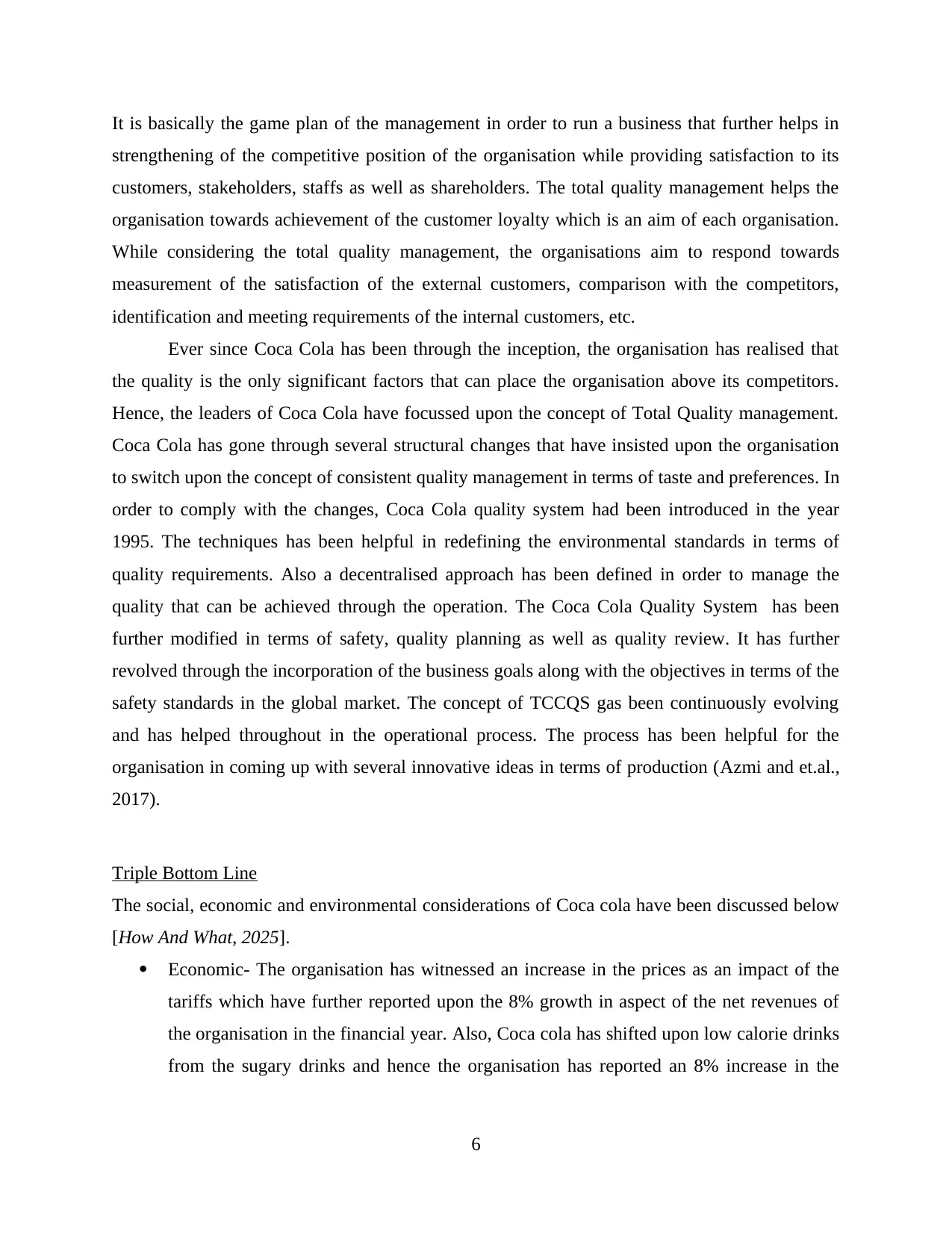
It is basically the game plan of the management in order to run a business that further helps in
strengthening of the competitive position of the organisation while providing satisfaction to its
customers, stakeholders, staffs as well as shareholders. The total quality management helps the
organisation towards achievement of the customer loyalty which is an aim of each organisation.
While considering the total quality management, the organisations aim to respond towards
measurement of the satisfaction of the external customers, comparison with the competitors,
identification and meeting requirements of the internal customers, etc.
Ever since Coca Cola has been through the inception, the organisation has realised that
the quality is the only significant factors that can place the organisation above its competitors.
Hence, the leaders of Coca Cola have focussed upon the concept of Total Quality management.
Coca Cola has gone through several structural changes that have insisted upon the organisation
to switch upon the concept of consistent quality management in terms of taste and preferences. In
order to comply with the changes, Coca Cola quality system had been introduced in the year
1995. The techniques has been helpful in redefining the environmental standards in terms of
quality requirements. Also a decentralised approach has been defined in order to manage the
quality that can be achieved through the operation. The Coca Cola Quality System has been
further modified in terms of safety, quality planning as well as quality review. It has further
revolved through the incorporation of the business goals along with the objectives in terms of the
safety standards in the global market. The concept of TCCQS gas been continuously evolving
and has helped throughout in the operational process. The process has been helpful for the
organisation in coming up with several innovative ideas in terms of production (Azmi and et.al.,
2017).
Triple Bottom Line
The social, economic and environmental considerations of Coca cola have been discussed below
[How And What, 2025].
Economic- The organisation has witnessed an increase in the prices as an impact of the
tariffs which have further reported upon the 8% growth in aspect of the net revenues of
the organisation in the financial year. Also, Coca cola has shifted upon low calorie drinks
from the sugary drinks and hence the organisation has reported an 8% increase in the
6
strengthening of the competitive position of the organisation while providing satisfaction to its
customers, stakeholders, staffs as well as shareholders. The total quality management helps the
organisation towards achievement of the customer loyalty which is an aim of each organisation.
While considering the total quality management, the organisations aim to respond towards
measurement of the satisfaction of the external customers, comparison with the competitors,
identification and meeting requirements of the internal customers, etc.
Ever since Coca Cola has been through the inception, the organisation has realised that
the quality is the only significant factors that can place the organisation above its competitors.
Hence, the leaders of Coca Cola have focussed upon the concept of Total Quality management.
Coca Cola has gone through several structural changes that have insisted upon the organisation
to switch upon the concept of consistent quality management in terms of taste and preferences. In
order to comply with the changes, Coca Cola quality system had been introduced in the year
1995. The techniques has been helpful in redefining the environmental standards in terms of
quality requirements. Also a decentralised approach has been defined in order to manage the
quality that can be achieved through the operation. The Coca Cola Quality System has been
further modified in terms of safety, quality planning as well as quality review. It has further
revolved through the incorporation of the business goals along with the objectives in terms of the
safety standards in the global market. The concept of TCCQS gas been continuously evolving
and has helped throughout in the operational process. The process has been helpful for the
organisation in coming up with several innovative ideas in terms of production (Azmi and et.al.,
2017).
Triple Bottom Line
The social, economic and environmental considerations of Coca cola have been discussed below
[How And What, 2025].
Economic- The organisation has witnessed an increase in the prices as an impact of the
tariffs which have further reported upon the 8% growth in aspect of the net revenues of
the organisation in the financial year. Also, Coca cola has shifted upon low calorie drinks
from the sugary drinks and hence the organisation has reported an 8% increase in the
6
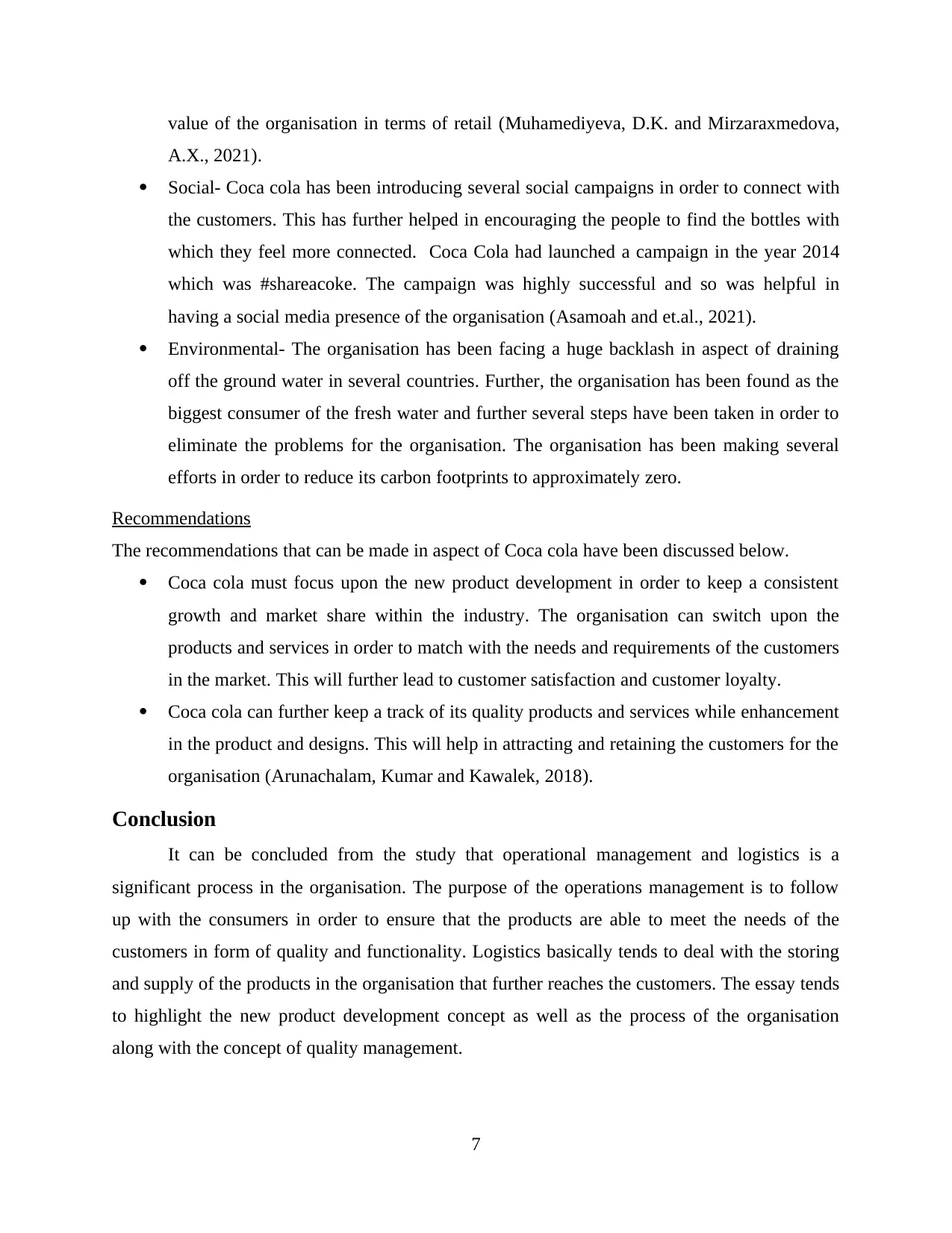
value of the organisation in terms of retail (Muhamediyeva, D.K. and Mirzaraxmedova,
A.X., 2021).
Social- Coca cola has been introducing several social campaigns in order to connect with
the customers. This has further helped in encouraging the people to find the bottles with
which they feel more connected. Coca Cola had launched a campaign in the year 2014
which was #shareacoke. The campaign was highly successful and so was helpful in
having a social media presence of the organisation (Asamoah and et.al., 2021).
Environmental- The organisation has been facing a huge backlash in aspect of draining
off the ground water in several countries. Further, the organisation has been found as the
biggest consumer of the fresh water and further several steps have been taken in order to
eliminate the problems for the organisation. The organisation has been making several
efforts in order to reduce its carbon footprints to approximately zero.
Recommendations
The recommendations that can be made in aspect of Coca cola have been discussed below.
Coca cola must focus upon the new product development in order to keep a consistent
growth and market share within the industry. The organisation can switch upon the
products and services in order to match with the needs and requirements of the customers
in the market. This will further lead to customer satisfaction and customer loyalty.
Coca cola can further keep a track of its quality products and services while enhancement
in the product and designs. This will help in attracting and retaining the customers for the
organisation (Arunachalam, Kumar and Kawalek, 2018).
Conclusion
It can be concluded from the study that operational management and logistics is a
significant process in the organisation. The purpose of the operations management is to follow
up with the consumers in order to ensure that the products are able to meet the needs of the
customers in form of quality and functionality. Logistics basically tends to deal with the storing
and supply of the products in the organisation that further reaches the customers. The essay tends
to highlight the new product development concept as well as the process of the organisation
along with the concept of quality management.
7
A.X., 2021).
Social- Coca cola has been introducing several social campaigns in order to connect with
the customers. This has further helped in encouraging the people to find the bottles with
which they feel more connected. Coca Cola had launched a campaign in the year 2014
which was #shareacoke. The campaign was highly successful and so was helpful in
having a social media presence of the organisation (Asamoah and et.al., 2021).
Environmental- The organisation has been facing a huge backlash in aspect of draining
off the ground water in several countries. Further, the organisation has been found as the
biggest consumer of the fresh water and further several steps have been taken in order to
eliminate the problems for the organisation. The organisation has been making several
efforts in order to reduce its carbon footprints to approximately zero.
Recommendations
The recommendations that can be made in aspect of Coca cola have been discussed below.
Coca cola must focus upon the new product development in order to keep a consistent
growth and market share within the industry. The organisation can switch upon the
products and services in order to match with the needs and requirements of the customers
in the market. This will further lead to customer satisfaction and customer loyalty.
Coca cola can further keep a track of its quality products and services while enhancement
in the product and designs. This will help in attracting and retaining the customers for the
organisation (Arunachalam, Kumar and Kawalek, 2018).
Conclusion
It can be concluded from the study that operational management and logistics is a
significant process in the organisation. The purpose of the operations management is to follow
up with the consumers in order to ensure that the products are able to meet the needs of the
customers in form of quality and functionality. Logistics basically tends to deal with the storing
and supply of the products in the organisation that further reaches the customers. The essay tends
to highlight the new product development concept as well as the process of the organisation
along with the concept of quality management.
7
Paraphrase This Document
Need a fresh take? Get an instant paraphrase of this document with our AI Paraphraser
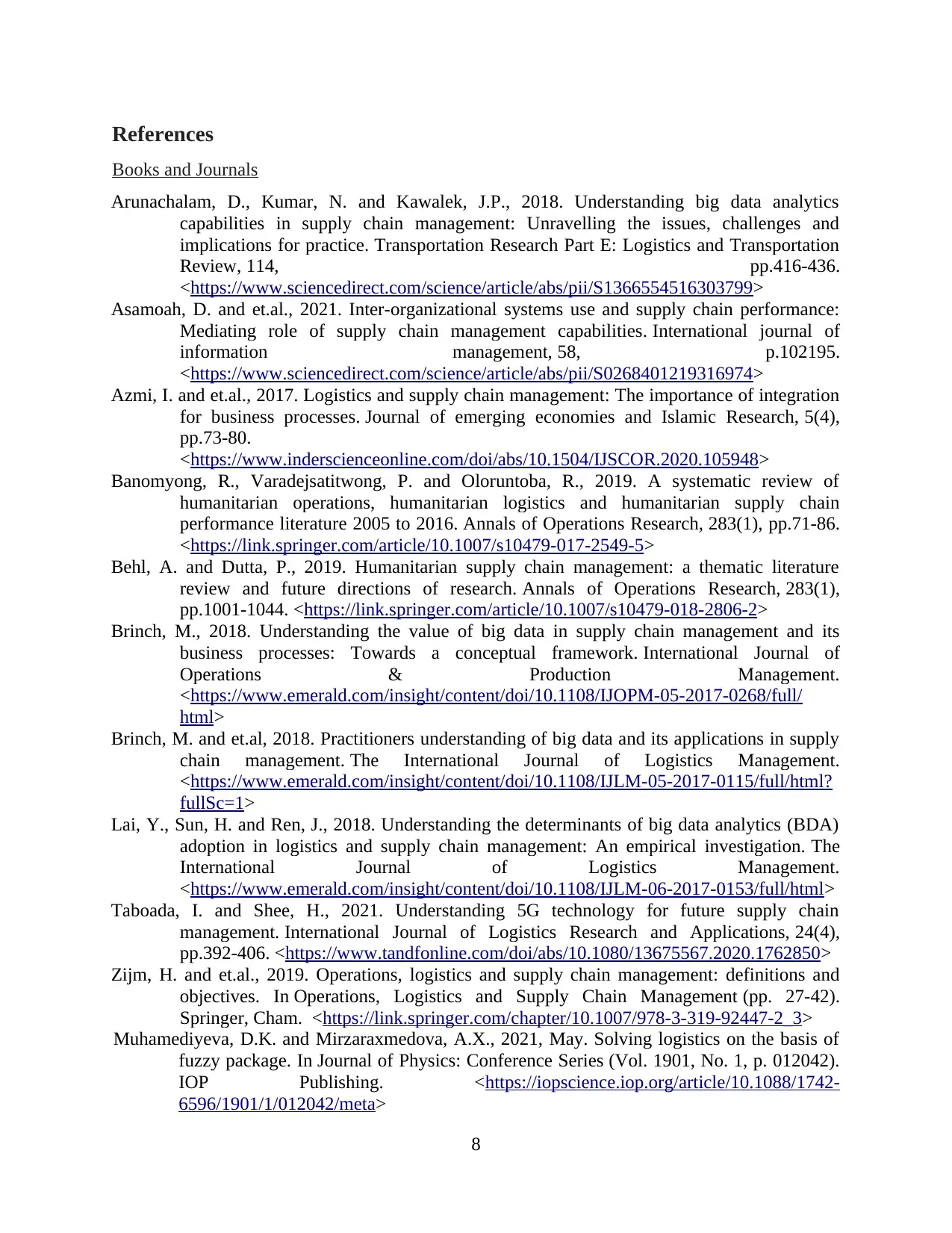
References
Books and Journals
Arunachalam, D., Kumar, N. and Kawalek, J.P., 2018. Understanding big data analytics
capabilities in supply chain management: Unravelling the issues, challenges and
implications for practice. Transportation Research Part E: Logistics and Transportation
Review, 114, pp.416-436.
<https://www.sciencedirect.com/science/article/abs/pii/S1366554516303799>
Asamoah, D. and et.al., 2021. Inter-organizational systems use and supply chain performance:
Mediating role of supply chain management capabilities. International journal of
information management, 58, p.102195.
<https://www.sciencedirect.com/science/article/abs/pii/S0268401219316974>
Azmi, I. and et.al., 2017. Logistics and supply chain management: The importance of integration
for business processes. Journal of emerging economies and Islamic Research, 5(4),
pp.73-80.
<https://www.inderscienceonline.com/doi/abs/10.1504/IJSCOR.2020.105948>
Banomyong, R., Varadejsatitwong, P. and Oloruntoba, R., 2019. A systematic review of
humanitarian operations, humanitarian logistics and humanitarian supply chain
performance literature 2005 to 2016. Annals of Operations Research, 283(1), pp.71-86.
<https://link.springer.com/article/10.1007/s10479-017-2549-5>
Behl, A. and Dutta, P., 2019. Humanitarian supply chain management: a thematic literature
review and future directions of research. Annals of Operations Research, 283(1),
pp.1001-1044. <https://link.springer.com/article/10.1007/s10479-018-2806-2>
Brinch, M., 2018. Understanding the value of big data in supply chain management and its
business processes: Towards a conceptual framework. International Journal of
Operations & Production Management.
<https://www.emerald.com/insight/content/doi/10.1108/IJOPM-05-2017-0268/full/
html>
Brinch, M. and et.al, 2018. Practitioners understanding of big data and its applications in supply
chain management. The International Journal of Logistics Management.
<https://www.emerald.com/insight/content/doi/10.1108/IJLM-05-2017-0115/full/html?
fullSc=1>
Lai, Y., Sun, H. and Ren, J., 2018. Understanding the determinants of big data analytics (BDA)
adoption in logistics and supply chain management: An empirical investigation. The
International Journal of Logistics Management.
<https://www.emerald.com/insight/content/doi/10.1108/IJLM-06-2017-0153/full/html>
Taboada, I. and Shee, H., 2021. Understanding 5G technology for future supply chain
management. International Journal of Logistics Research and Applications, 24(4),
pp.392-406. <https://www.tandfonline.com/doi/abs/10.1080/13675567.2020.1762850>
Zijm, H. and et.al., 2019. Operations, logistics and supply chain management: definitions and
objectives. In Operations, Logistics and Supply Chain Management (pp. 27-42).
Springer, Cham. <https://link.springer.com/chapter/10.1007/978-3-319-92447-2_3>
Muhamediyeva, D.K. and Mirzaraxmedova, A.X., 2021, May. Solving logistics on the basis of
fuzzy package. In Journal of Physics: Conference Series (Vol. 1901, No. 1, p. 012042).
IOP Publishing. <https://iopscience.iop.org/article/10.1088/1742-
6596/1901/1/012042/meta>
8
Books and Journals
Arunachalam, D., Kumar, N. and Kawalek, J.P., 2018. Understanding big data analytics
capabilities in supply chain management: Unravelling the issues, challenges and
implications for practice. Transportation Research Part E: Logistics and Transportation
Review, 114, pp.416-436.
<https://www.sciencedirect.com/science/article/abs/pii/S1366554516303799>
Asamoah, D. and et.al., 2021. Inter-organizational systems use and supply chain performance:
Mediating role of supply chain management capabilities. International journal of
information management, 58, p.102195.
<https://www.sciencedirect.com/science/article/abs/pii/S0268401219316974>
Azmi, I. and et.al., 2017. Logistics and supply chain management: The importance of integration
for business processes. Journal of emerging economies and Islamic Research, 5(4),
pp.73-80.
<https://www.inderscienceonline.com/doi/abs/10.1504/IJSCOR.2020.105948>
Banomyong, R., Varadejsatitwong, P. and Oloruntoba, R., 2019. A systematic review of
humanitarian operations, humanitarian logistics and humanitarian supply chain
performance literature 2005 to 2016. Annals of Operations Research, 283(1), pp.71-86.
<https://link.springer.com/article/10.1007/s10479-017-2549-5>
Behl, A. and Dutta, P., 2019. Humanitarian supply chain management: a thematic literature
review and future directions of research. Annals of Operations Research, 283(1),
pp.1001-1044. <https://link.springer.com/article/10.1007/s10479-018-2806-2>
Brinch, M., 2018. Understanding the value of big data in supply chain management and its
business processes: Towards a conceptual framework. International Journal of
Operations & Production Management.
<https://www.emerald.com/insight/content/doi/10.1108/IJOPM-05-2017-0268/full/
html>
Brinch, M. and et.al, 2018. Practitioners understanding of big data and its applications in supply
chain management. The International Journal of Logistics Management.
<https://www.emerald.com/insight/content/doi/10.1108/IJLM-05-2017-0115/full/html?
fullSc=1>
Lai, Y., Sun, H. and Ren, J., 2018. Understanding the determinants of big data analytics (BDA)
adoption in logistics and supply chain management: An empirical investigation. The
International Journal of Logistics Management.
<https://www.emerald.com/insight/content/doi/10.1108/IJLM-06-2017-0153/full/html>
Taboada, I. and Shee, H., 2021. Understanding 5G technology for future supply chain
management. International Journal of Logistics Research and Applications, 24(4),
pp.392-406. <https://www.tandfonline.com/doi/abs/10.1080/13675567.2020.1762850>
Zijm, H. and et.al., 2019. Operations, logistics and supply chain management: definitions and
objectives. In Operations, Logistics and Supply Chain Management (pp. 27-42).
Springer, Cham. <https://link.springer.com/chapter/10.1007/978-3-319-92447-2_3>
Muhamediyeva, D.K. and Mirzaraxmedova, A.X., 2021, May. Solving logistics on the basis of
fuzzy package. In Journal of Physics: Conference Series (Vol. 1901, No. 1, p. 012042).
IOP Publishing. <https://iopscience.iop.org/article/10.1088/1742-
6596/1901/1/012042/meta>
8
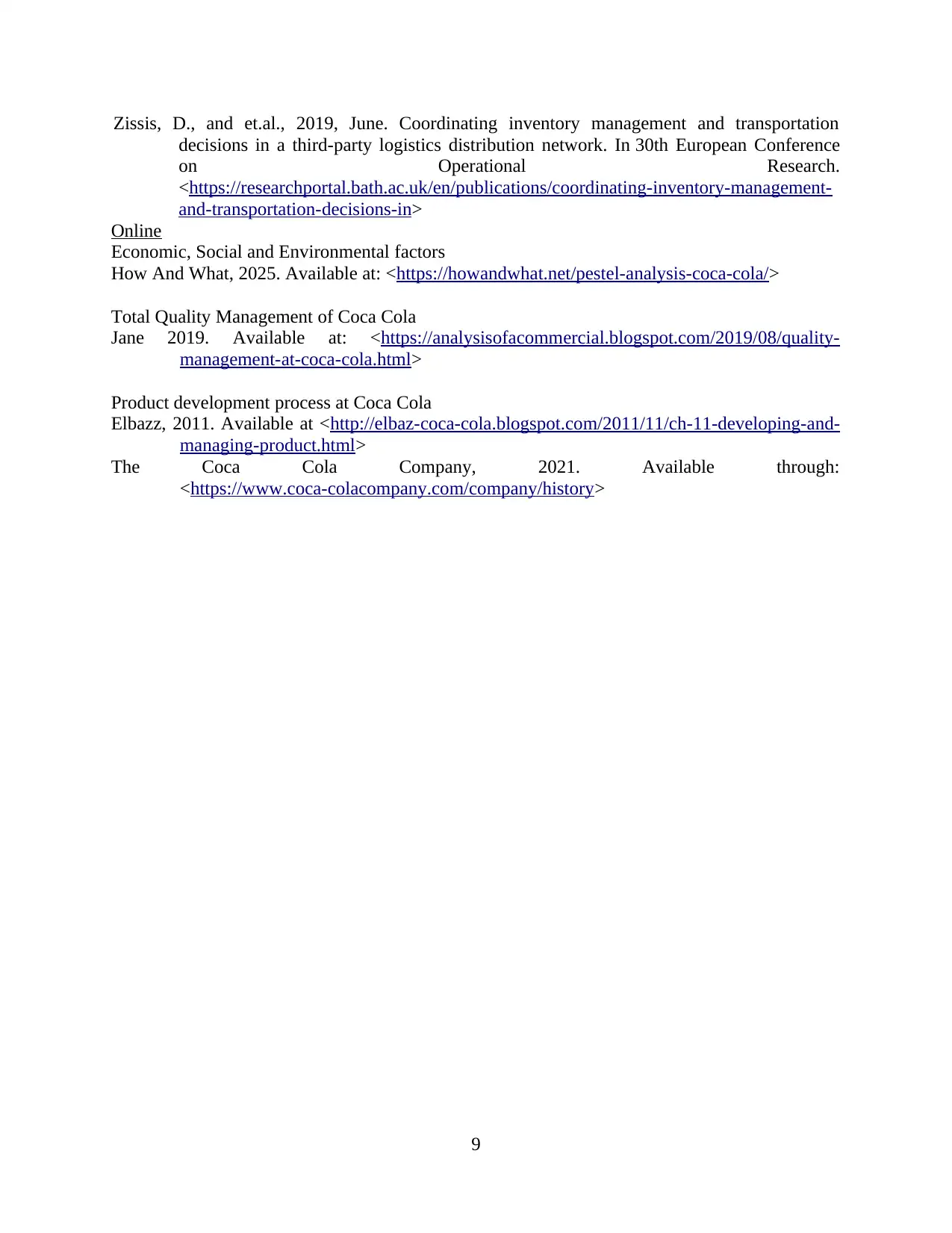
Zissis, D., and et.al., 2019, June. Coordinating inventory management and transportation
decisions in a third-party logistics distribution network. In 30th European Conference
on Operational Research.
<https://researchportal.bath.ac.uk/en/publications/coordinating-inventory-management-
and-transportation-decisions-in>
Online
Economic, Social and Environmental factors
How And What, 2025. Available at: <https://howandwhat.net/pestel-analysis-coca-cola/>
Total Quality Management of Coca Cola
Jane 2019. Available at: <https://analysisofacommercial.blogspot.com/2019/08/quality-
management-at-coca-cola.html>
Product development process at Coca Cola
Elbazz, 2011. Available at <http://elbaz-coca-cola.blogspot.com/2011/11/ch-11-developing-and-
managing-product.html>
The Coca Cola Company, 2021. Available through:
<https://www.coca-colacompany.com/company/history>
9
decisions in a third-party logistics distribution network. In 30th European Conference
on Operational Research.
<https://researchportal.bath.ac.uk/en/publications/coordinating-inventory-management-
and-transportation-decisions-in>
Online
Economic, Social and Environmental factors
How And What, 2025. Available at: <https://howandwhat.net/pestel-analysis-coca-cola/>
Total Quality Management of Coca Cola
Jane 2019. Available at: <https://analysisofacommercial.blogspot.com/2019/08/quality-
management-at-coca-cola.html>
Product development process at Coca Cola
Elbazz, 2011. Available at <http://elbaz-coca-cola.blogspot.com/2011/11/ch-11-developing-and-
managing-product.html>
The Coca Cola Company, 2021. Available through:
<https://www.coca-colacompany.com/company/history>
9
1 out of 9
Related Documents
Your All-in-One AI-Powered Toolkit for Academic Success.
+13062052269
info@desklib.com
Available 24*7 on WhatsApp / Email
![[object Object]](/_next/static/media/star-bottom.7253800d.svg)
Unlock your academic potential
© 2024 | Zucol Services PVT LTD | All rights reserved.





